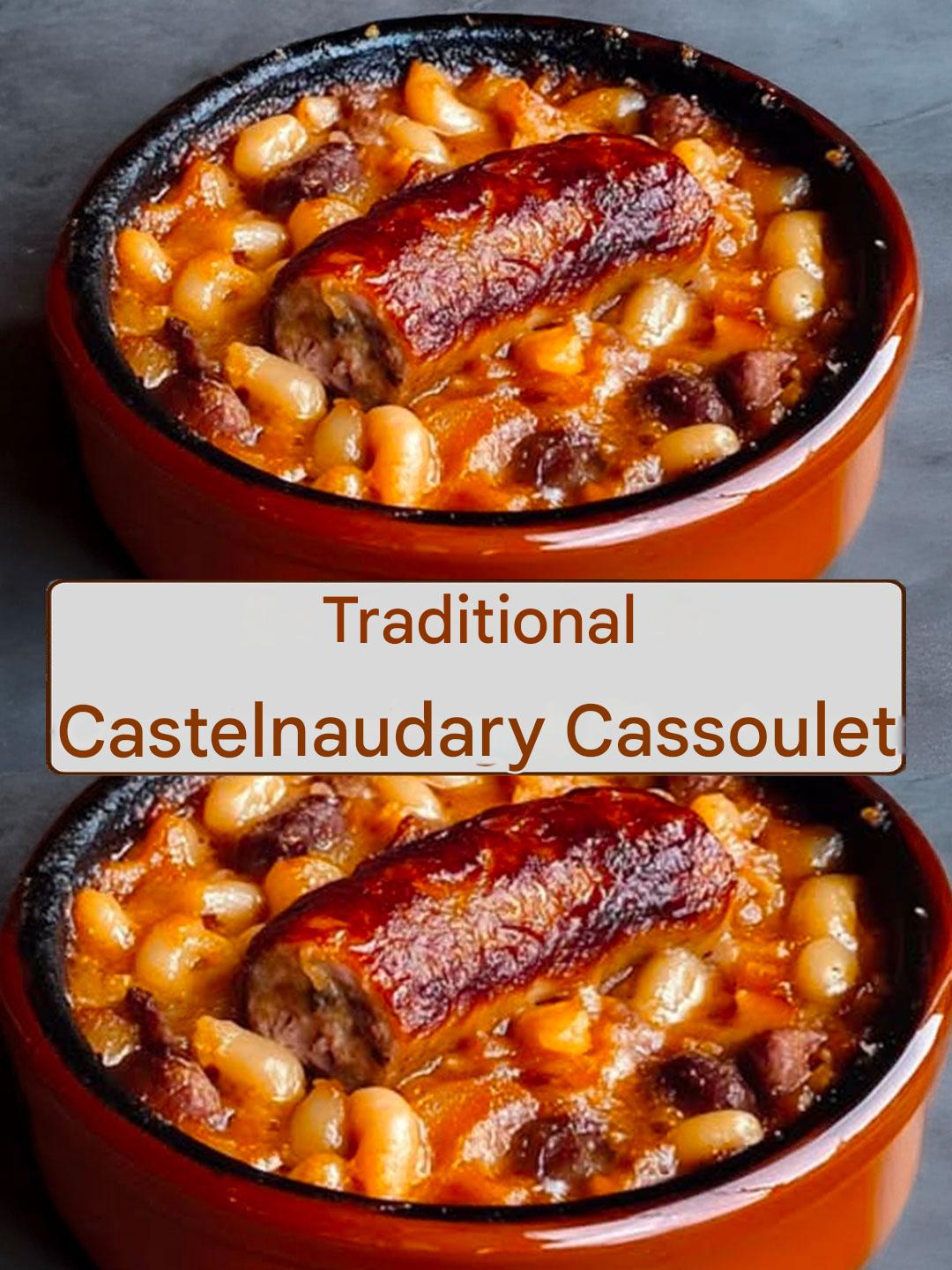Storage & Reheating
What to Serve With This Cassoulet
Nutrition Facts
FAQs
Related Recipes
Conclusion
Introduction
If you’ve ever wondered what comfort food from the French countryside tastes like, this traditional cassoulet de Castelnaudary recipe will transport you straight to the hearth of Languedoc, where time slows down and every bite tells a story. I discovered my love for this dish during a cold winter evening in Toulouse—surrounded by warmth, hearty aromas, and the crackle of duck fat sizzling. From the very first mouthful of tender white beans and rich meats immersed in savory broth, I knew I had found a dish worth sharing.
Why You’ll Love This Traditional Cassoulet de Castelnaudary Recipe
-
It’s deeply comforting: slow‐cooked beans absorb rich flavours from duck confit, pork and sausage.
-
It’s rooted in tradition: this dish is emblematic of the town of Castelnaudary and the Languedoc region of Southern France.
-
It’s ideal for sharing: large one‐pot cooking means minimal fuss, maximum flavour, and time with loved ones.
-
It’s even better the next day: the flavour develops over time, making leftovers a treat.
Ingredients
-
800 g dried white beans (preferably Tarbais or Lingot variety)
-
1 large onion, studded with 2 cloves
-
2 carrots, sliced
-
1 bouquet garni (thyme, bay leaf, parsley)
-
2 L cold water
-
200 g pork rind/couenne, cut into strips
-
400 g pork shoulder, cut into chunks
-
1 jarret de porc (pork shank) or equivalent, bone in
-
4 duck confit legs (with fat)
-
4 – 5 Toulouse sausages
-
200 g smoked bacon or pork belly, cut into cubes
-
3 — 4 garlic cloves, minced
-
Salt & freshly ground black pepper
-
Optional: a splash of tomato purée for depth
-
Equipment: a cassole (traditional earthenware dish) or heavy oven‑proof pot
Instructions
Bean preparation
-
The night before: rinse the beans, pick out any debris. Soak in plenty of cold water overnight.
-
Drain and rinse beans next day. In a large pot, combine beans + onion‐with‐cloves + carrots + bouquet garni + pork rind strips. Cover with cold water (~2 L). Bring to a gentle boil, then simmer for ~30 minutes until beans are just tender but still hold shape. Drain, reserving some cooking liquid. Remove onion & bouquet.
Meat preparation
-
Preheat your oven to 150 °C (300 °F).
-
In a skillet or pot, render duck fat from the confit legs. Remove legs, set aside.
-
In that fat, brown the pork shoulder chunks and bacon until nicely caramelised. Add pork shank pieces and brown lightly. Remove meats and set aside.
-
Brown the Toulouse sausages briefly just to develop flavour.
Assembly & oven cooking
-
In your cassole or oven‑proof dish, layer as follows: a layer of pork rind strips at the bottom → then a third of the beans → all the browned meats (except duck legs) → another third of beans → duck confit legs & sausages on top → remaining beans. The sausages should be partly visible.
-
Pour the reserved bean cooking liquid (or stock) over the assembly so that the beans are just covered (but not swimming). Season generously with salt & pepper.
-
Cover and place in oven. Cook for 2 to 3 hours. Every ~20–30 minutes, a crust will form on top — use the back of a wooden spoon to gently break the crust and push it back into the liquid (traditionally this is done “seven times”). If the dish appears dry, add a little hot stock.
-
When done, the beans should be meltingly tender, the meats deeply flavourful, and a golden crust formed on top. Let the cassoulet rest ~10 minutes before serving.
Tips for Success
-
Use quality beans with thin skins so they soften well but don’t disintegrate.
-
Choose good meats: duck confit legs bring depth, pork shoulder brings richness, Toulouse sausage adds character.
-
Don’t rush it: low, slow cooking is the key to flavour and texture.
-
Crumbling the crust several times helps incorporate flavours and gives that rustic tradition.
-
The next day, the cassoulet often tastes even better—flavours have had time to meld.
Variations
-
Vegetarian version: Replace the meats with smoked tofu, mushrooms, and vegetable stock—but note this won’t be traditional.
-
Lamb version: Some regions (e.g., Carcassonne) use lamb or mutton; you could substitute lamb shoulder for pork.
-
Fast version: Use canned white beans and a shorter oven time—but the depth of flavour will be reduced.
Ingredient Substitutions
-
If you can’t find duck confit: use chicken thighs slowly roasted with olive oil, though flavour will differ.
-
If you can’t find Toulouse sausage: use a mild pork sausage and smoke it lightly yourself.
-
If beans soak time is short: use hot water soak + quick blanching—but soaking overnight remains best.
Storage & Reheating
-
Store leftovers in the fridge for up to 3 days.
-
Reheat gently in the oven at 160 °C (325 °F) until piping hot—add a splash of stock if the dish seems dry.
-
You can also freeze portions (without crust) for up to 3 months. Thaw overnight in fridge, then reheat.
What to Serve With This Cassoulet
-
A rustic country loaf or baguette to soak up the juices.
-
A robust red wine from the Languedoc region (e.g., Corbières, Minervois) that can stand up to the richness.
-
A simple green salad with vinaigrette to provide freshness and balance.
Nutrition Facts (approximate per serving)
-
Calories: ~750‑900 kcal
-
Protein: ~45‑55 g
-
Fat: ~40‑60 g (depending on meat cuts)
-
Carbohydrates: ~45‑60 g (from beans)
-
Fibre: ~10 g
Note: This is a rich, indulgent dish—perfect occasionally rather than daily.
FAQs
Q1. Can I make the cassoulet ahead of time?
Yes! In fact, many believe it tastes even better the next day after resting. Assemble, refrigerate overnight, then bake just before serving for optimal flavour.
Q2. Why break the crust during cooking?
This traditional technique melds top flavours into the dish and gives the cassoulet its signature texture. It also prevents the crust from becoming too hard.
Q3. Do I have to use an earthenware cassole?
While an authentic cassole is ideal (it retains heat gently), a heavy oven‑proof pot or Dutch oven will work well too.
Q4. Is cassoulet gluten‑free?
Yes — if you only use bean, meat and stock ingredients (no flour or breadcrumbs). Always check sausage ingredients for any hidden gluten.
Related Recipes
-
[Classic French Beef Bourguignon] – another slow‑cooked French comfort dish
-
[Duck Confit with Herb Potatoes] – highlights duck confit in a simpler context
-
[White Bean Ragout with Smoked Sausage] – a lighter bean‐and‐sausage one‑pot meal
Conclusion
This traditional cassoulet de Castelnaudary recipe isn’t just food—it’s heritage, warmth and generosity in a dish. It invites you to slow down, gather loved ones around the table, and savour each rich spoonful of beans and meats cooked to perfection. If you love a dish that rewards patience and celebrates flavour, this is one you’ll return to time and time again.

